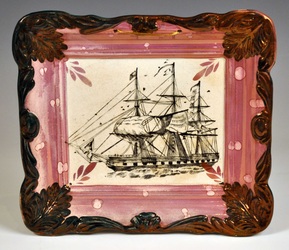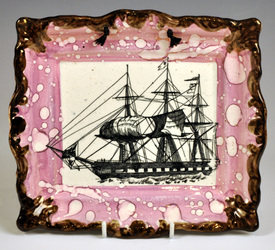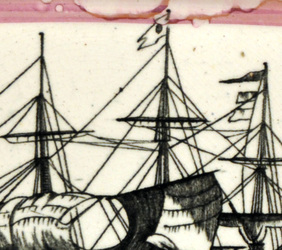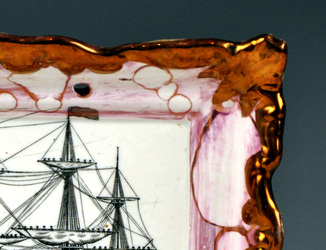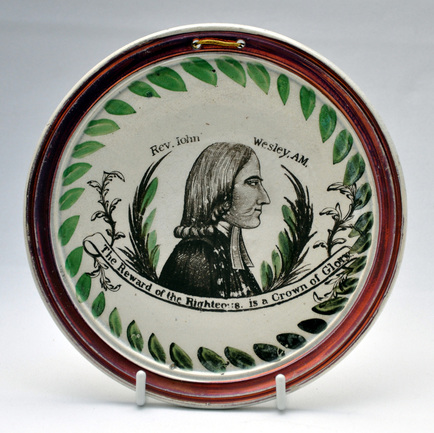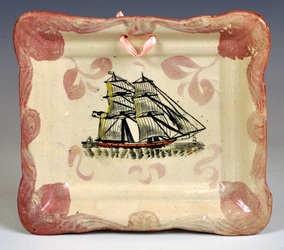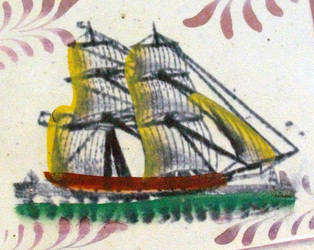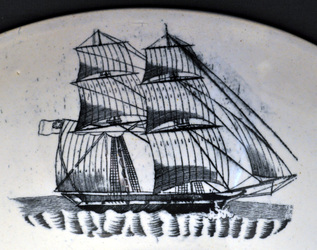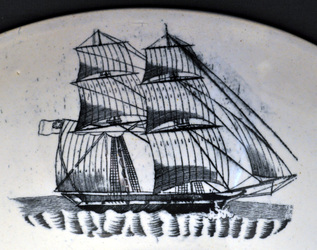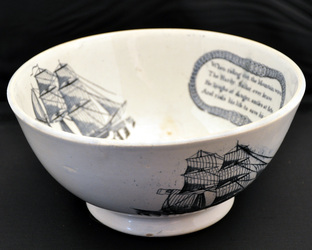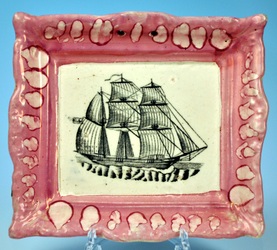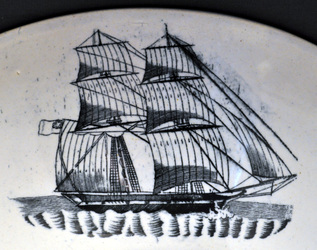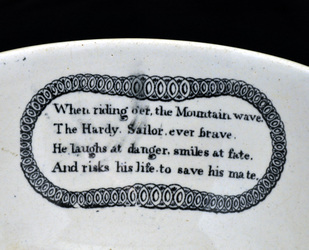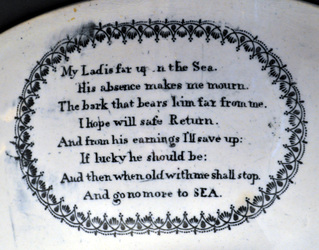|
7/31/2011 0 Comments More on Carr ship plaquesFirst of all, a quick note on my current preoccupation with John Carr. For the other major North East potteries that produced plaques – Dixon, Moore, Scott and Maling – we can form a picture of how their products changed through the 1830s, 40s and 50s (see the plaque dates page for an overview). But for Carr, there is a black hole. We know that Cornfoot, Colville & Co produced many pink lustre plaques between 1829 and c1832 at the Northumberland Pottery in North Shields. We know that from 1861 onwards, John Carr & Sons, on the same site (by then known as the Low Lights Pottery), produced pink lustre plaques – like the one with the impressed mark in my previous post. It seems a fairly safe assumption that throughout the period c1832–1861 the production of pink lustre plaques continued. The partnerships between those dates are (according to Bell): Cornfoot, Carr & Patton, 1834–1847 Carr & Patton, 1847–1848 John Carr, 1848–c1850 John Carr & Co, c1850–1854 John Carr & Son (note singular), 1854–1861 The plaques produced in the earlier partnerships would likely have been of higher quality than those produced from 1861 onwards. So perhaps Carr's finest plaques remain unattributed. Carr & Patton also took over the Phoenix Pottery, Ouseburn, in 1847. Bell writes that their partnership was apparently dissolved a year later, with John Carr continuing at the Low Lights Pottery and John Patton at the Phoenix Pottery. Separating their wares of the 1850s might be difficult, unless we can show that transfer plates continued to be used by the later Carr partnerships. The engraving below of the ship Marco Polo appeared in The Illustrated London News in 1853. And yet the plaque, attributed to John Carr's Low Lights pottery, was likely made in the 1860s. So did one of the earlier Carr partnerships make plaques using the same transfer during the 1850s? The smaller plaques with this transfer are amongst the most common of all the maritime plaques, and must have been produced in their thousands. How many of the potteries could have coped with such a large production run? But there are at least two variations of the transfer (discounting the modern reproductions titled Agamemnon). Look at the plaques below and their details, particularly the flags (click to enlarge and to move from one photo to another). The first two have a flag on the first mast, the third doesn't. The first two have seagulls flying around the masts, the third doesn't. Through tiny flaws in the engraving, I am certain the first two come from the same transfer plate. The third plaque is a low quality variation, produced in much smaller numbers. The transfer is over-glaze, and I suspect it was produced later than the other two plaques. Its dimensions are within a couple of millimetres of the first plaque. So the thousands of plaques out there like the first one above, were likely produced by John Carr & Co from c1853 when the engraving was published, and John Carr & Son after that. Those like the second plaque were likely produced by John Carr & Sons in the 1860s, when taste shifted to plaques with wider borders. The third plaque is late (maker unknown), but highlights the danger of making sweeping attributions without looking closely at the transfers. Click on the details of the two plaques below. Remember, every dot and line of shading was engraved by hand. These two plaques are clearly from the same transfer plate. As we'd expect, the transfer of 1860's plaque on the right shows evidence of wear. So the link between Carr and the plaques in group 2 of my previous post, I hope is clearly established. However, there are some very obvious differences between the 'Prepare' and 'Thou God' in group 2, and their 1860's counterparts. But I have a pile of shirts to iron, so the differences will have to wait for another post.
0 Comments
I've measured a variety of plaques which I've tentatively attributed to John Carr's Low Lights Pottery, North Shields. Group 1Most of this first group share the lustre decoration I talked about in a previous post. Oil appears to have been dropped at regular intervals around the frame. Gibson, in his book on Lustreware, writes 'An overall coating of pink lustre would be sprayed with fine drops of oil while still wet. These formed small pools on the surface which, when fired and the oil had burnt away, left the surface mottled'. The borders on most of the group 1 plaques have a variegated (almost striped) appearance (see below left). Compare them with the more irregular lava-lamp quality of the Dixon plaques (below right). There are variations of about half a centimetre in some of the sizes (see below). N.B. these plaques all come from quite deep moulds (circa 40 mm). We would expect some variation amongst these deep plaques, even if they came from the same mould. Before their first firing, they would have been prone to distortion through handling, and I guess there was the possibility that the clay might 'sag' or 'droop' a little. Looking at the photos below, the odd one out appears to be the centre right which has less 'pinched' corners than the others, and almost certainly comes from a different mould. Top left, 210 x 187 mm Top right, 215 x 190 mm Middle left, 214 x 188 mm Middle right, 215 x 193 mm Bottom left, 216 x 186 mm Bottom right, 218 x 185 mm Group 2On the surface of it, these look like a great match in terms of size. But the first mould (top left) is much deeper (circa 40 mm) and the plaque is heavier than the rest. The other five plaques are only circa 25 mm deep. As I've proposed above, their shallower depth may account for the much smaller degree of variation in their length and width, i.e. this mould holds its shape well. These plaques are attributed to Carr on the basis of the similarity of their transfers to the large plaques with rounded corners (see my July 23rd post). Top left, 207 x 180 mm Top right, 205 x 182 mm Middle left, 205 x 182 mm Middle right, 205 x 182 mm Bottom left, 205 x 182 mm Bottom right, 206 x 182 mm So how do these compare with the dimensions of our marked Carr plaque (below), decorated in a similar manner to group 1? Well my apologies to anyone who hoped this could be neatly wrapped up. It is significantly bigger than the plaques in either group. 'Prepare' plaque with impressed mark, 220 x 199 mm Group 1 average, 215 x 188 mm Group 2 average, 205 x 182 mm But that's not to say the plaques above aren't Carr! Expect more posts.
I recently e-mailed the Northern Ceramic Society about John Cockerill's article on North Eastern pottery with 'London' impressed marks. When John replied I got much more than I bargained for. He sent me an image of the fabulous Maling Wesley plaque below. As my Wesleyana-collector friends have never seen one before, I can only assume that if it isn't a one off, it is exceptionally rare. It has the horse-shoe shaped Maling impressed mark, used from 1817. (This reminds me that one day soon, I need to add the Maling marks to the Maling plaques page.) Thanks to Ian Holmes and Keith Lovell for sharing images of the cups below, both attributed to Leeds pottery. The top right photo shows the image on the creamware loving cup reversed. It seems that this image was the inspiration for the transfer on the plaque. Note the palm leaf in the bottom right hand corner of the reversed image. Keith was told by the dealer selling the cup (bottom left) that its flower decoration was typical of Leeds, but he now wonders whether it too could be Maling. Needless to say I've joined the Northern Ceramic Society, which provides members with a qurterly newsletter and annual journal, both illustrated with colour photos, and holds regular meetings, summer schools and museum visits. I wish I'd joined years ago! Thanks to Joyce and Jack Cockerill for their friendly e-mails and advice.
Please read my previous blog post first. A variant of the third ship transfer on the bowl, which I said was the most common of the series, appears on plaques with a circular impressed mark for Galloway & Atkinson's Albion Pottery (c1864). On the Albion plaques, the ship is titled 'Gudrun' (see first plaque below). I've not been able to find out anything yet about the ship Gudrun. As with the bowl, this plaque has a firing crack and glaze imperfections, and was therefore left undecorated. So did G&A (or C T Maling, their predecessor at the pottery before they changed its name to 'Albion'), make the other plaques below? Perhaps the title 'Gudrun' was added at a later date? The plaque below is much better quality than those that follow it. I'd guess it was made c1850s. Compare the right detail with the Gudrun plaque above. Though the waves follow a similar formation, they are clearly from different plates. Also look at the shape of the flags in the centre detail and note the seagulls on the plaques below. Here's the plaque from my previous post, with the transfer that didn't match the bowl. It does, however, match the transfer on the plaque above. The two larger plaques beneath it, usually attributed to John Carr's Low Lights Pottery, also have transfers from the same plate. They were produced around the same time as the Gudrun plaque (c 1860s), but note how the quality of the imprint has deteriorated. N.B. one of the two ships on the right of the horizon has disappeared on the later plaques (click details to enlarge). So to recap, there are at least three variations of the transfer, which I've shown below for comparison. The first one titled Gudrun was used by the Albion Pottery on plaques with the G&A impress. The second appears on larger plaques attributed to John Carr. The bowl is still a bit of a mystery. For the reasons stated in my previous posting, I think it is Carr. This would mean that Carr had two very similar transfer plates. But why not? Remember that Anthony Scott had four almost identical 'Prepare' transfer plates. So does the third transfer (on the bowl) ever appear on plaques? Yes it does. The orange plaque below has a rare 'portrait' orientation. It is from an as yet unidentified pottery, perhaps dating from as late as the 1890s. Ball's Deptford Pottery is the default attribution for orange lustre plaques. But J Carr and Sons continued to produce pottery until 1900. Thanks to Ian Holmes for his comments and for helping me out with photos. Have you visited the United Collections website recently?
7/20/2011 0 Comments Bowl with three shipsI bought the bowl below on eBay recently. It was listed as Staffordshire, presumably because it lacks lustre decoration, but I think it was made in Tyneside. It has a small firing flaw, so was probably sold undecorated as a factory second. I bought it because the ship transfers matched those found on plaques (see below). The central column of photos shows the transfer on each plaque. The right column of photos shows the transfer on the bowl. I'm satisfied the first two plaques have transfers from the same transfer plates as the bowl. The last, however, has subtle differences: boats on the horizon; seagulls. Below are the three verses on the bowl (click to enlarge). The verse on the bottom left appears on plaques attributed to Scott and Carr. This version is most similar to the Scott transfer (bottom right). However, it is from a different transfer plate. (Incidentally, if you look at the top right corner of the verse you'll see the firing flaw I talked about above.) So who made the bowl? My hunch is John Carr. Look at the quality of the lustre on the plaque below left with the Carr impressed mark. The edges are scuffed and the lustre has faded and rubbed in the same way as the first two ship plaques above. There's also something about the way the lustre is applied, with splashes at regular intervals, almost like stripes. Obviously I'll have to do more to convince you! And there's still the problem of the third ship transfer, which doesn't match that on the bowl. It's the most common of the three and has several variants.
Perhaps you have a jug or bowl with one of the three verses above? If so, please get in touch. |
AuthorStephen Smith lives in London, and is always happy to hear from other collectors. If you have an interesting collection of plaques, and are based in the UK, he will photograph them for you. Free advice given regarding selling and dispersal of a collection, or to those wishing to start one. Just get in touch... Archives
February 2022
AcknowledgementsThis website is indebted to collectors, dealers and enthusiasts who have shared their knowledge or photos. In particular: Ian Holmes, Stephen Duckworth, Dick Henrywood, Norman Lowe, Keith Lovell, Donald H Ryan, Harold Crowder, Jack and Joyce Cockerill, Myrna Schkolne, Elinor Penna, Ian Sharp, Shauna Gregg at the Sunderland Museum, Keith Bell, Martyn Edgell, and Liz Denton.
|



